April 18, 2014
Air Date: April 18, 2014
FULL SHOW
SEGMENTS

Bargain Time For Climate Protection
View the page for this story
The 2104 climate mitigation report from the IPCC says the price of climate action today is cheap compared to what it will cost, if delays continue. Physicist Joseph Romm, who heads the blog Climate Progress, and host Steve Curwood discuss the IPCC’s cost-benefit analysis of immediate and delayed climate action. (11:00)

Fossil Fuel Divestment Gains New Supporters
/ Bobby BascombView the page for this story
A growing movement across the country is demanding that institutions pull their investments out of fossil fuel companies. Living on Earth’s Bobby Bascomb reports that in Massachusetts, pensioners, professors, and students all urge divestment from the corporations most responsible for climate change. (06:30)

Top Banana
/ Bob CartyView the page for this story
In honor of Earth month we’ve been revisiting some of our favorite stories. This week it’s Bob Carty’s 2004 tale of the ubiquitous Cavendish banana, and the dire threats to its future. (15:55)
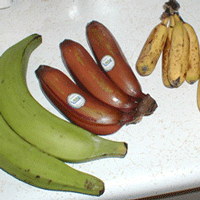
Bananageddon
View the page for this story
Update-The deadly fungus Tropical Race 4 Panama Disease that destroys bananas broke out in Asia, but over time has spread to the Middle East and Africa. University of Florida plant pathologist Randy Ploetz tells host Steve Curwood that scientists are now concerned that the disease could also make its way to Latin America. (04:20)

Beyond the Headlines
/ Peter DykstraView the page for this story
In this week’s trip beyond the headlines, Peter Dykstra tells host Steve Curwood that ocean acidification seems to alter a fish’s sense of smell, and examines the origins of the word Luddite. (05:05)

Earthday Haikus
View the page for this story
April is National Poetry Month, and with Earth Day right around the corner, Living on Earth is asked listeners to send in their Earth Day inspired Haiku poems. Here are some highlights! (03:00)
Show Credits and Funders
Show Transcript
HOST: Steve Curwood
GUESTS: Joseph Romm, Randy Ploetz,
REPORTERS: Bobby Bascomb, Bob McCarty, Peter Dykstra
[THEME]
CURWOOD: From Public Radio International, this is Living on Earth.
[THEME]
CURWOOD: I’m Steve Curwood. Pay now or pay a lot more later. That's the message of the latest UN climate science report, that acting now is cost-effective.
ROMM: We have a closing window to aggressively cut emissions, and stabilize carbon pollution at levels that are viewed as not catastrophic, but every year that you wait adds more to the cost.
CURWOOD: Also, the movement to divest fossil fuels from pension funds and college endowments picks up more traction.
ONION: Frankly, I'm terrified because I know what climate change is going to do to this world but there are things we can do to make the damage less and divestment is the most powerful thing that we can do as students.
CURWOOD: And some of your Earth Day haiku. We’ll have those stories and more this week on Living on Earth. Stick around.
[NEWSBREAK MUSIC: Boards Of Canada “Zoetrope” from “In A Beautiful Place Out In The Country” (Warp Records 2000)]
ANNOUNCER: Funding for Living on Earth comes from Stonyfield Farm, makers of organic yogurt, smoothies and more.
Bargain Time For Climate Protection

The IPCC warns increasing temperatures will eventually stress water resources, making certain places inhospitable. (Photo: CIAT, Wikimedia Commons)
CURWOOD: From the Jennifer and Ted Stanley Studios in Boston and PRI, this is Living on Earth. I’m Steve Curwood. Urgent action now, or a king's ransom later. That’s the word from the Intergovernmental Panel on Climate Change. As part of the latest assessment, IPCC scientists did the math of the costs and benefits of cutting greenhouse gas emissions quickly and deeply. They found that stalling on action now will only raise the price to deal with the inevitable: rising seas, drought and climate-forced migrations. We asked former assistant energy secretary Joe Romm to weigh in on the report’s recommendations. He’s an author, physicist, and climate expert who heads the blog “Climate Progress”. Welcome to Living on Earth, Joe.
ROMM: Thanks for having me.
CURWOOD: How much has public perception changed about climate since you were Assistant Secretary for Energy?
ROMM: Oh, well that was back in the mid-1990s, and I think the general awareness is considerably higher, both about the impact of climate change and the solutions. And I think in particular, the off-the-charts extreme weather of the last three years has clearly influenced a lot of people and made them realize that climate change is right here, right now.
CURWOOD: Joe, how fair is it to say that the IPCC report claims that we’re headed for economic disaster if we don’t act quickly and strongly? Some folks say that it just costs too much in the economy to do the kind of things that are being recommended.
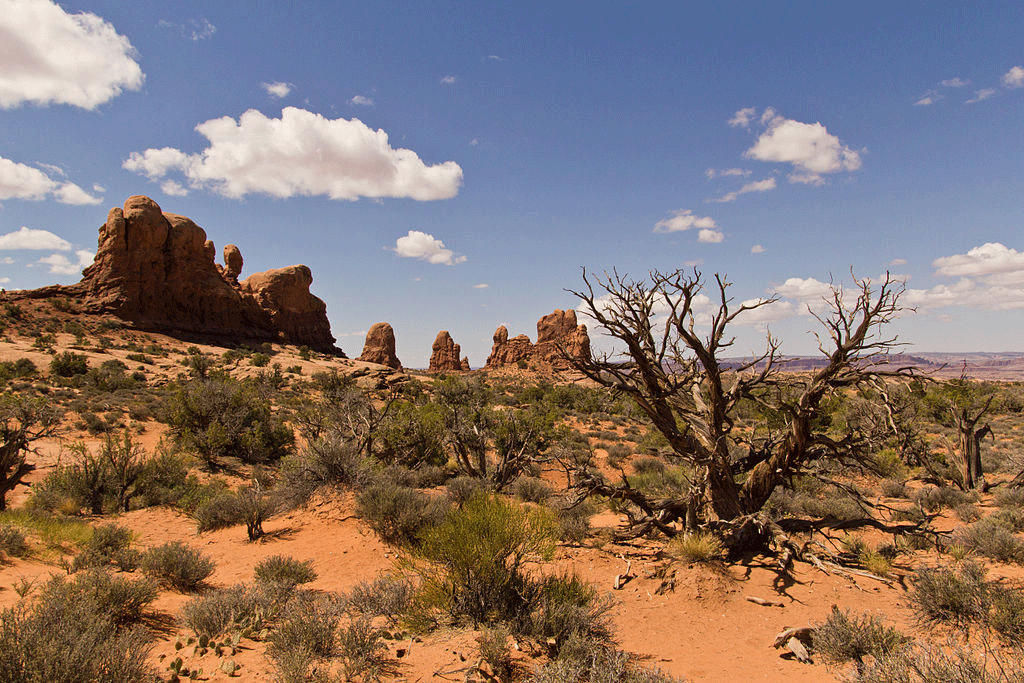
The UN’s IPCC says if we continue with business as usual, climate change will make many areas around the world arid and inhospitable, displacing millions of people. (Photo: Katsrcool, Wikimedia Commons)
ROMM: Well, I think that the new IPCC report lays to rest the notion that it is expensive to act, and, in fact, it actually says that stabilizing the climate would cost about 0.06 percent of economic growth per year. 0.06 percent. It would be the difference of having global economic growth of two percent versus 2.06 percent, so really a drop in the bucket. Many of the people who have spoken about this have made clear that we know we’re kind of running out of time. We have a closing window to aggressively cut emissions, and stabilize carbon pollution at levels that are viewed as not catastrophic, but that window is closing and every year that you wait adds more to the cost, and indeed it’s, you know, the International Energy Agency that previously calculated that every dollar you spend now saves $4 after the year 2020. The cost of inaction is enormous: steadily rising seas, ever worsening droughts, problems with food, problems with conflict, the heatwave, superstorms. And the co-chair of the committee that wrote this report said, “we cannot afford to lose another decade. If we lose another decade it becomes extremely costly to achieve climate stabilization.”
CURWOOD: The IPCCs chairperson Dr. Pachauri has said that, and I quote here: “The high-speed mitigation train needs to leave the station very soon, and all of global society needs to get on board.” What do you make of that statement?
ROMM: Well, we have to start being much more aggressive in the carbon-free sources. I mean the good news is that a couple of decades of major investment have really brought the cost of solar power down a stunning amount. I mean, we’re talking about a 99 percent drop in the cost of solar power in the last quarter century, and a very rapid drop in the cost of wind power, and other drops, of course, in batteries and energy efficient equipment. So the technology is there, but we have to ramp it up at a much faster rate if we are going to avoid, you know, destroying a livable climate.
CURWOOD: What about the notion that it’s really cheap to use carbon-polluting fossil fuels and other things, cutting trees, that add to global warming and that some folks say that we need to put a price on carbon so people make other choices.
ROMM: Well, absolutely. Right now, there’s no cost for carbon pollution, so people can just treat the atmosphere as an open sewer, whereas we know that carbon pollution has a significant economic cost to us and a cost in human health. So one obvious thing to do, which economists have always advised, is to make the cost of pollution equivalent to its harm to humans and society, and this IPCC report, when it’s looking at what is the most cost-effective way for the world to deal with climate change, a price on carbon is one of the top policies.

Logo for the Intergovernmental Panel on Climate Change (Photo: Wikipedia)
CURWOOD: Now what does the IPCC say about fossil fuels and our energy economy in general?
ROMM: It says that if you want to stabilize carbon pollution at livable levels, then you have to start very aggressively expanding some combination of renewable energy, energy efficiency, nuclear power, and carbon-capture and storage - and that’s where you capture the carbon pollution coming out of a fossil fuel plant - and that has to rapidly expand. We’re using more fossil fuels today than we can be using in 2050, so even in the case of natural gas, which some people see as a bridge fuel, it’s only a bridge fuel if it’s considerably less leaky that we know it is today because natural gas is mostly methane, and when it leaks out of the ground, it is a potent greenhouse gas. And secondly, we need to peak in natural gas consumption, you know, over the next decade or two, and then get down to levels below current levels by 2050. So the world really has to make a concerted global effort to get off carbon pollution and fossil fuels.
CURWOOD: What’s the time scale here, Joe? How quickly do we have to make these changes if we want to avoid these, well at least the most catastrophic, consequences of climate disruption?
ROMM: The IPCC warns that there are various tipping points that will, once they’re crossed, become very hard if not impossible to come back to. At some point, you have triggered a rate of sea level rise that really can’t be reversed. The same for changes in temperature rises, and one of the biggest concerns raised in the first report, was that you would trigger a defrosting of the permafrost in the Arctic region - Siberia, Canada, Alaska - and if it starts to defrost then it emits carbon both in the form of carbon dioxide and methane which is an even more potent greenhouse gas. So there is a great concern that we are approaching these thresholds and tipping points. And you know these are not the kinds of risks you would ever take in your personal life if you could avoid them at a low cost, and we know we can avoid them at a low cost. But it does mean this is the decade we have to act.
CURWOOD: What do you make of the IPCC’s recommendation in this report that involves the burning of biomass in conjunction with carbon capture and sequestration? First, tell me what that process is, and then tell me how effective you think it might be.
ROMM: There are some, but not a lot, of demonstrations around the world of burning fossil fuel, particularly coal, where instead of releasing the carbon dioxide into the atmosphere, you capture it and stick it underground in some sort of permanent repository like a well or a deep underground aquifer. Now if you could take biomass, which is just plant matter that just grew by absorbing CO2 and burn that and capture its carbon, then plants will take the carbon out of the air and the carbon capture would then put the carbon underground. You know, we are certainly going to have to have an all hands on deck approach because of all of our you know quarter century of dawdling. So I do think we’re certainly going to have to try carbon capture and storage with biomass, but it’s clear that no one would do that if there wasn’t a price on carbon.
CURWOOD: So what do you make of the IPCC essentially recommending a form of geo-engineering here -- if you burn biomass and then do carbon capture and sequestration...it’s a form of geo-engineering.
ROMM: We’re doing geo-engineering now by pumping massive amounts of carbon pollution into the atmosphere and heating the planet up, melting ice and changing the Earth’s climate patterns. There’s nothing wrong with trying to pull CO2 out of the air. I think it should be obvious to almost anybody that not putting the carbon dioxide into the air is always going to be a lot cheaper compared to sort of burning the coal when it’s just sitting there in the ground as solid carbon in the first place.
CURWOOD: Now, many people around the world are, of course, already feeling the impacts of climate change, on every continent. What does the report say about the need for adaptation?
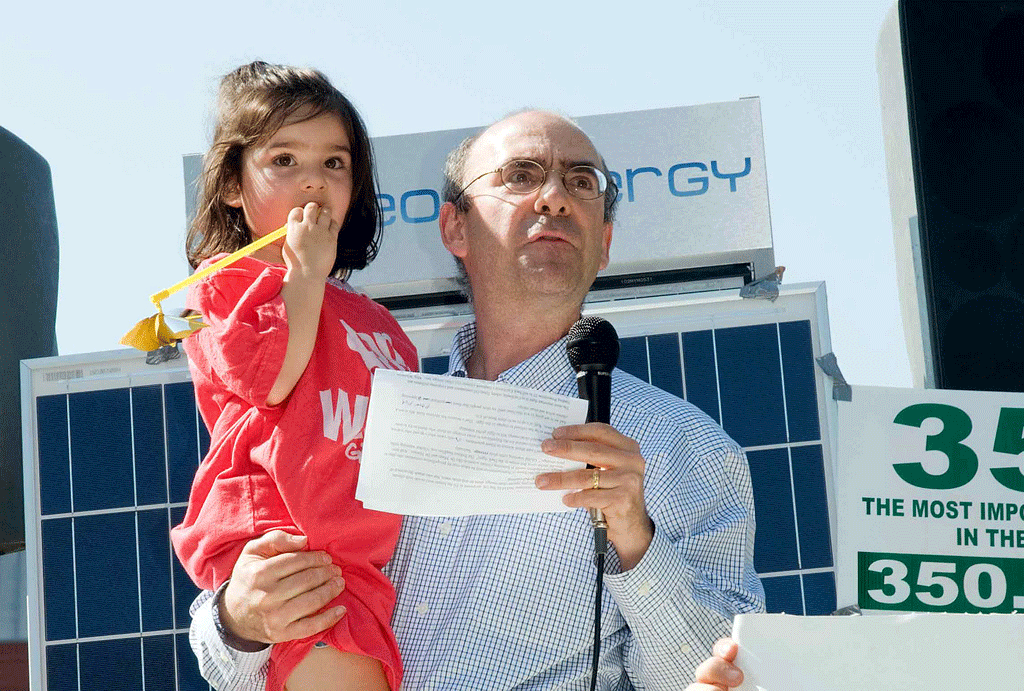
Joe Romm holding his daughter and speaking out on climate change in Washington DC (photo: 350.org, creative commons 2.0)
ROMM: There’s no question that we are stuck with serious climate change, and, yes, everyone is going to have to adapt. There is no escape from that. The issue is that if you don’t take effort to mitigate, to reduce carbon pollution, most climate experts would tell you that adaptation can’t be accomplished in a meaningful sense of the word. The classic way that humans have adapted in the past is to abandon uninhabitable areas. The word “desert” comes from the same derivation as a deserted place. It is an abandoned place. It’s a place you can’t live anymore. Now, we are, according to lay science, turning more and more parts of the world into dust bowls and deserts, so you know people can adapt by simply leaving. Now clearly, if you are talking about places where hundreds of millions of people live, where are they going to go without creating some sort of strife?
This question of how we are going to feed nine billion people after the year 2050 is a great, great concern of the IPCC and that may require a very different farming system. We’re going to have to redesign our agricultural and food delivery system to minimize ways to maximize the use whatever arable land and freshwater we have. We are talking about deep and abiding change in the lives in the lives of billions of people. Change, by the way, we are forcing on them because of our greed and myopia, because we simply won’t spend this small fraction of our wealth to prevent decades if not centuries of a worsening climate that people will have to suffer through.
CURWOOD: Joe Romm is a Senior Fellow at the Center for American Progress where he edits the blog “Climate Progress”. Joe, thanks so much for taking the time with us today sharing your insights.
ROMM: Thanks for having me.
Related links:
- IPCC Mitigation Report
- IPCC Homepage
- Joe Romm’s Climate Progress Blog
[MUSIC: Herbie Mann “Memphis Underground” from Memphis Underground (Atlantic Records 1969)]
CURWOOD: Coming up...retired teachers, university professors and students team up to promote political and fiscal action to fight global weirding. Keep listening to Living on Earth.
[CUTAWAY MUSIC: Herbie Hancock: “Thieves In The Temple” from The New Standard (Verve Records 1998)]
Fossil Fuel Divestment Gains New Supporters

(Bobby Bascomb)
CURWOOD: It's Living on Earth, I'm Steve Curwood. The IPCC report says that to preserve a livable planet, we can't afford to burn all the fossil fuel reserves that companies have on their books. Investments in fossil fuels have been highly profitable, but company valuation is based on those reserves, and some warn that's increasingly risky. And a growing movement is calling for institutions and individuals to divest of those stocks for both moral and financial reasons. Divestment has been a powerful weapon before - it helped end apartheid in South Africa. In Massachusetts, the call for divestment is echoing both in the State House and at America’s richest university, Harvard. Living on Earth’s Bobby Bascomb has our story.
[CROWD CHANTS “DIVEST NOW! DIVEST NOW!”]
BASCOMB: Some 100 protestors are standing in front of the gold dome of the Massachusetts state house. They carry signs that read “climate justice now” and “break up with fossil fuels.” But these aren’t your usual climate activists. They are all retired state employees. Rachel Wyan used to teach school in Cambridge.
WYAN: We’re public employees and teachers and we’re working for the future. We’re working for our children and grandchildren and future generations. At least that’s what we would hope we want to have in the future, a livable planet for them. But we’re investing in the destruction of the air, the water, the earth.
BASCOMB: Roughly $1.3 billion of the Massachusetts’ state pension fund is directly invested in fossil fuel companies. More than a year ago, State Senator Ben Downing introduced Bill S 1225. It would require that state pension funds remove those investments within five years. The bill is currently waiting for a committee to make recommendations. That’s expected to take several more months but pensioner Richard Horsely, a retired University of Massachusetts professor, says there’s no time to wait to cut greenhouse gas emissions.
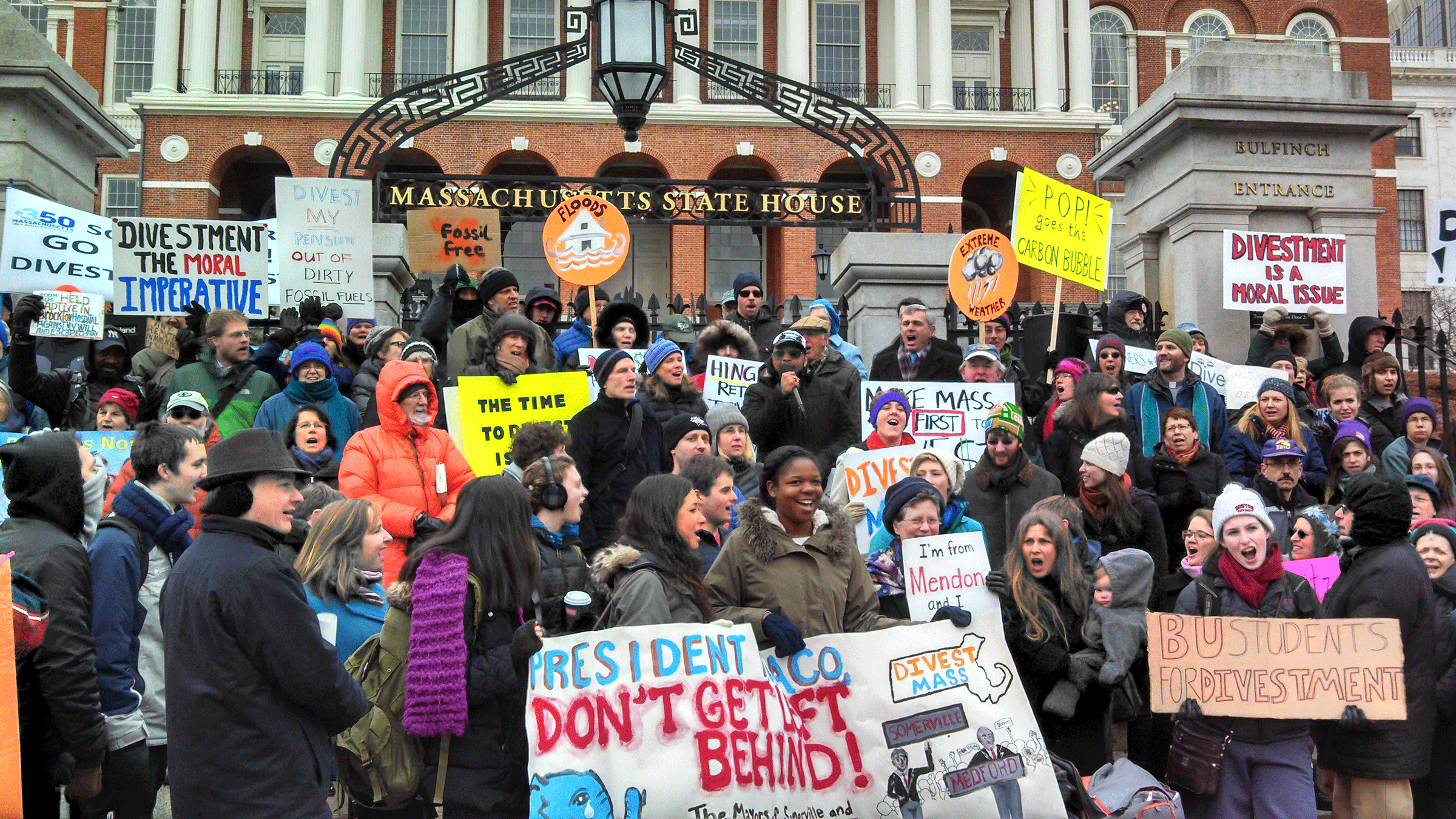
State employees rally outside the Massachusetts state house to demand the legislature divest their pensions from fossil fuel stocks. (Bobby Bascomb)
HORSELY: We’ve already passed the limit that we can afford with global warming. So we think it’s very important that in every possible way we move to stop fossil fuels. And Massachusetts must be the leader in this. It’s always been a leader. And it’s time for Massachusetts legislature to act now to divest our pension funds.
[CROWDING CHANTING: “WE ARE UNSTOPABLE, ANOTHER WORLD IS POSSIBLE”]
BASCOMB: Massachusetts is currently the only state with an active divestment bill working its way through the legislature. Vermont had a similar bill but it was rejected in March.
BASCOMB: At the end of the rally some of the pensioners marched into the state house here in Boston to lobby their representatives directly.
On the other side of the Charles River in Cambridge, Harvard University professors are taking a different approach to the same goal. More than 100 of them recently signed an open letter to Harvard President Drew Faust urging the university to divest its endowment from fossil fuel stocks. Joyce Chaplin teaches early American history; she’s one of the four professors who originally wrote the letter.
CHAPLIN: Continued consumption of fossil fuels will lead to higher and higher levels of carbon in the atmosphere and this will have disastrous consequences across the face of the planet. There will be warming and weirder weather. There will be acidification of the ocean. There will be loss of habitat for species that will go extinct. So we feel that continued interaction with these corporations is a bad idea, and we want the university to make a stand.

Harvard students rally for the university to divest from fossil fuels. (Divest Harvard)
BASCOMB: Harvard has the largest university endowment in the world, more than 30 billion dollars. No one here thinks divesting will cause the fossil fuel companies serious harm but it will send a strong message. Andrew Berry is a professor of evolutionary biology.
BERRY: Harvard has the opportunity to send a very clear signal, and it’s a signal which will be amplified and taken notice of because it’s Harvard University. So, for me it’s a no-brainer. What we’re doing is creating awareness that we as academics, as people who think hard about these things, people who understand the science, who understand the models, who understand the future scenarios, think that weaning ourselves off these fuels is a bloody good idea.
BASCOMB: But university administrators do not think it’s a good idea. Harvard president Drew Faust declined an interview, but she recently wrote an open e-mail to faculty and students. It read in part, “divestment from the fossil fuel industry would not be wise or effective as a means for the University to advance progress towards addressing climate change.”
Harvard does says it will become a signatory to the United Nations supported Principles for Responsible Investing - a voluntary guideline which some students see as inadequate. For the long term, President Faust argues that Harvard should work towards energy efficiency on campus and continue cutting-edge research on climate science and new technologies to mitigate climate change. Noticeably, President Faust never mentions lost revenue as a reason to retain fossil fuel stocks, but she does state that, “the endowment is a resource, not an instrument to impel social or political change.”
ONION: I disagree with that, obviously, because the fact that the endowment is currently invested in fossil fuels is a political statement in itself.
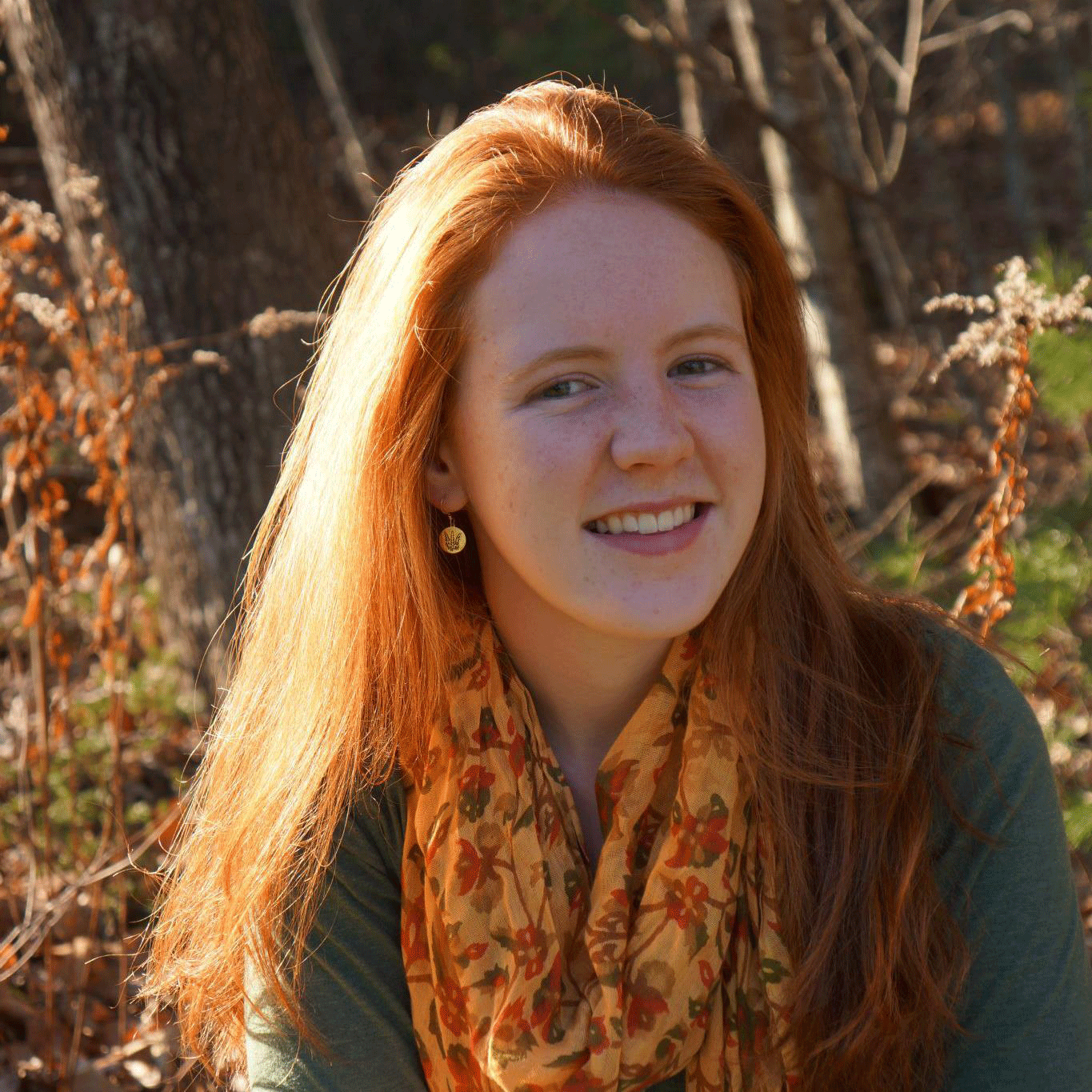
Zoe Onion is a freshman molecular biology major at Harvard. (Zoe Onion)
BASCOMB: 18-year-old Zoe Onion is a molecular biology major and one of the student organizers for divestment. Zoe says for her this is a moral issue.
ONION: Frankly, I’m terrified—because I’ve seen the numbers. I know what climate change is going to do to this world. I know that we are already on this path and there’s nothing we can do to get off it, but there are things we can do to make the damage less, and there things we can do to make our lives and the lives of our children better. I believe that it’s really important to do whatever we can and divestment is the most powerful thing we can do as students.
BASCOMB: Bill McKibben’s organization 350.org has taken the divestment campaign to more than 100 colleges across the country. And it’s gaining some traction - ten universities have already pledged to pull their endowment cash out of fossil fuels. But here in the Bay State, students, professors, and pensioners alike hope there’s still time for Harvard and Massachusetts as a whole, to take a leadership role when it comes to removing investments from fossil fuel corporations.
[CROWD CHANTING “DIVEST! DIVEST!”]
For Living on Earth, I’m Bobby Bascomb in Boston, Massachusetts.
Related links:
- Drew Faust : Fossil Fuel Divestment Statement
- Drew Faust: Confronting Climate Change
- Divest Harvard
- Massachusetts Bill S 1225
[MUSIC: The Crusaders “Whispering Pines” from Southern Comfort (Verve Music group 1974)]
Top Banana
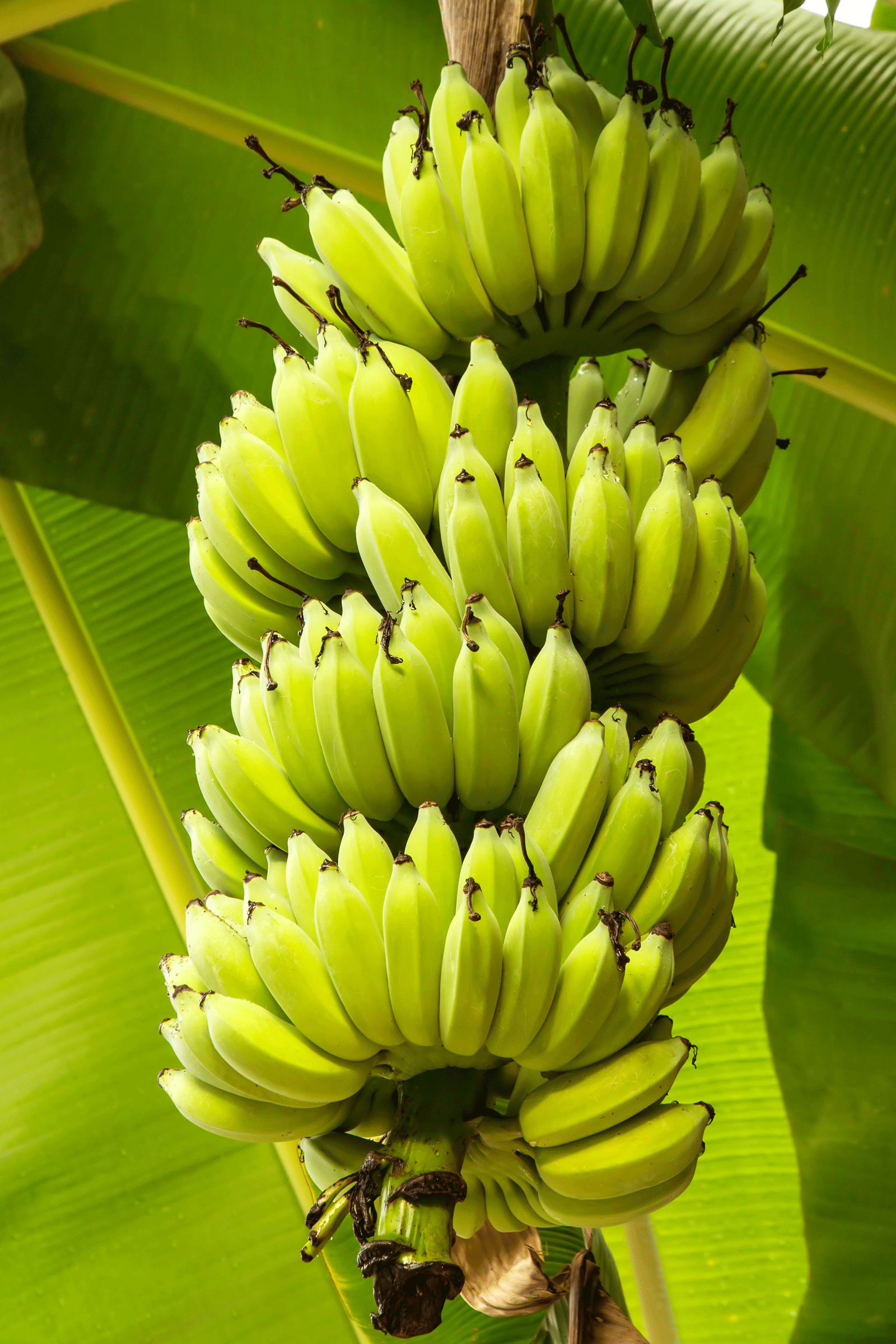
Cavendish bananas may not be the tastiest variety but they grow in huge bunches which makes them inexpensive to grow and bring to international markets. (bigstockphoto.com)
CURWOOD: We check in on some of our past stories during April - Earth Month - to find out what's happened with them since, and this week we're going bananas. A decade ago, producer Bob Carty reported that the world's most successful fruit - the big yellow banana - is under threat and might even be at risk of disappearing within this decade. Well, there are still bananas aplenty on the store shelves so that fate has been averted, but the threat remains. Here's Bob's documentary “Will The Banana Split?”
[SOUND OF OUTDOOR MARKET IN HONDURAS]
MCCARTY: In the Central American country of Honduras, the markets are full of bananas. And two things strike you right away. One is that the bananas on sale here are not the uniform and unblemished bananas we get in our supermarkets. Here, old men and young girls are selling bananas in all kinds of shapes and sizes.
CLIP: (Bob talks to vendors in market about different bananas… It’s a Philippino? So this is a plantain? What do you call these tiny little bananas there about a finger long? How many can you eat? Five?)
MCCARTY: And that’s the other thing you notice here. People eat a lot of bananas. Some shoppers are carrying off half a stalk – 60 or 70 ripe bananas. North Americans eat about 28 pounds of bananas a year … people here and in Africa eat as much as 500 pounds. Randy Ploetz is a professor of plant pathology at the University of Miami. He explains that 90% of all bananas are never exported, they’re eaten locally. They are the world’s fourth most important crop.
PLOETZ: Three to four hundred million people in the world depend upon it as primary source of carbohydrates. And international commerce in banana is worth about $5 billion a year.
MCCARTY: Which means a lot of people, a lot of nations, depend upon the banana tree.
PLOETZ: It’s actually a herb – it’s not a tree.
CARTY: You’re kidding – a herb?
PLOETZ: Yes. In fact there are bananas up to 15-20 feet – they are the world’s largest herbs. It’s really an ancient crop – 8,000, 9,000 years old.
MCCARTY: Now what’s also interesting is that the banana, which we usually associate with South America, is actually Asian. Muslim traders brought the banana from Asia to Africa. And then slave traders brought them to the Caribbean and Central America to feed their slaves. But according to Virginia Scott Jenkins, the author of “Bananas – An American History,” the fruit only became big business in the 1880s - with the development of refrigerated steam ships.
JENKINS: Then it was possible to transport bananas from the Caribbean to North American ports. So, US fruit companies went into Central America, purchased millions of acres of land and cut down the rainforest and planted thousands of acres of bananas.
[SOUNDS OF JUNGLE]
MCCARTY: And so the sounds of the rainforest were replaced by …
[SOUNDS OF BANANAS ON CABLES]
… the sound of banana stems being trundled from field to packing plant on overhead networks of cables. That’s how some of the most diverse ecologies on earth disappeared.
Growing bananas on an industrial scale was one thing. Next, firms like the United Fruit Company had to get northern consumers to buy them. Remember that in the 1880s, most even know what a banana looked like. And then there was a little cultural problem … the suggestive shape of the banana.
JENKINS: Well, the shape of the banana is a little difficult for some people, particularly in the Victorian era. Bananas were not considered very genteel. One of the interesting things I found was early instructions for how to eat a banana – etiquette books on what to do when you find a banana in front of you at a formal dinner party.
MCCARTY: Indeed – what to do? Well, readers of the 1888 edition of “The Correct Thing In Good Society” learned that the LAST thing you did was pick up a banana, pull back the skin and bite off a piece – especially if you were a woman. No, the proper way to face the fruit, if you had to at all, was with a silver fruit knife and fork.

Bananas come in all shapes, sizes and colors. (bigstockphoto.com)
The banana companies were able to overcome these cultural impediments, and they did it with aggressive marketing, extolling the virtues of the fruit, and pricing it right.
JENKINS: They sold them as the cheapest fruit on the market – and that was a deliberate decision by the fruit companies to undersell local fruit. And the marketing of bananas is absolutely amazing. The United Fruit Company marketed bananas with many health claims – for people trying to gain weight, people trying to lose weight – people who had tuberculosis, female complaints, asthma, all kinds of things.
[SONG: “I LIKE BANANAS”]
MCCARTY: The marketing campaigns worked. By the early 1900s bananas were everywhere. Even showing up in popular culture, especially in songs. Some of them … uh, rather sexual …
[SONG: “LET ME PUT MY BANANA IN YOUR FRUIT BASKET”]
… and some of them just kind of silly.
[SONG: “MY WIFE RAN OFF WITH A BANANA”]
[SOUNDS OF JUNGLE]
MCCARTY: Back in Central America, the banana business brought jobs and economic growth, but also a number of political problems. There was the predictable corruption that takes root when a foreign company buys up a big chunk of your nation. Then there were the company towns, the union-busting, the refusal by banana companies to pay taxes. All of which aroused a certain amount of local anger and protest, which in turn was met with American gunboat diplomacy.
[SONG – “BANANA REPUBLIC”]
MCCARTY: In the early decades of the 20th century, US Marines occupied Honduras five times, Panama four times, Nicaragua twice, to say nothing of other kinds of interventions in El Salvador, the Dominican Republic, Cuba, and Guatemala. And decade after decade banana production kept rising. But another problem was developing. Diseases kept killing banana plants. Randy Ploetz says the problem was the kind of banana they were growing.
PLOETZ: “Big Mike” - Gros Michel. A really excellent banana, produced very large bunches and very large fingers. You could chop the entire bunch down and throw it in the back of a railroad car and take it off to a ship so it didn’t require any special handling. It’s a really good banana.
[SONG: DAY-OH]
Oh, of course, how could I forget that – yeah now in fact in that song he’s talking about the Gros Michel, that was the banana that made the Jamaican trade so successful. Big Mike has all these great attributes that I mentioned earlier, but its Achilles heel is it’s very susceptible to Race One Panama disease – it’s a disease that’s caused by a soil-born fungus – it kills the plant outright.
And not only that, Panama disease couldn’t be controlled with fungicides. The only way the banana companies could keep ahead of Panama disease was by moving their plantations, cutting down more virgin rainforest to use soil that wasn’t diseased. But by the 1950s, they were running out of new rainforest to cut down. The Big Mike export banana was being wiped out.
[SONG: YES, WE HAVE NO BANANAS]
MCCARTY: But then we got lucky. And for this part of the story, meet another banana aficionado...
MARTINEZ: To me, if the world didn’t have bananas it would be a very boring place (laugh).
MCCARTY: This is Adolfo Martinez, the director-general of the Honduran Foundation for Agricultural Research. Adolfo explains that just as the Big Mike was withering away on the stem, they discovered the Cavendish banana, a banana that tasted almost as good as the Big Mike, but was also resistant to Panama disease. It was, however, a delicate fruit – it had to be shipped in protective boxes and plastic, and as Adolfo Martinez points out, it was very susceptible to another kind of banana disease called Black Sigatoka. And there’s only one way to fight that.
MARTINEZ: You have to use pesticides, you have to use fungicides with Cavendish – up to 50 times a year – that’s about weekly. The cost of that varies between $500 to 800 dollars a year per hectare.
CARTY: That means that a quarter of the price we pay for a bunch of bananas goes to drenching them in pesticides. Food inspectors say they don’t usually detect any pesticide residues in the fruit. The real impact of pesticides is on the health of banana workers and on the environment.
Back now to banana history - where along came, you guessed it, another problem. A new disease appeared just a couple of years ago. It’s a mutant of the old disease, called Tropical Race Four Panama disease. It’s now present in Indonesia, Taiwan, and Pakistan, perhaps elsewhere. And with global trade and travel, experts say it WILL inevitably get to this hemisphere.
MARTINEZ: It will be a disaster. And it will wipe out, completely, the Cavendish production that we have today.
[SONG – “YES, WE HAVE NO BANANAS”]
CARTY: What can be done about this looming disaster? Banana companies could try to develop a fungicide that works on this disease. Experts say that would be costly and would would mean using of a lot of fungicide … which wouldn’t make consumers or banana workers or the environment very happy.
Other experts are promoting a high-tech solution … genetically engineering the banana for resistance to diseases. Professor Randy Ploetz says there are institutes and companies actually working on this – trying to decode the banana’s DNA.
PLOETZ: Genetic engineering offers the glimmer of hope to produce a banana like the Cavendish that has only one thing changed … disease resistance.
[SONG: MELLOW YELLOW]
PLOETZ: But then what happens when you get that banana. I know people in Europe really are strongly opposed to that product. So you would lose a major market if you had that type of banana.
CARTY: Then there’s the possibility of creating a new banana by traditional breeding methods. Mating one kind of banana with another kind to get disease resistance plus good taste. The problem here has to do with sex ... or more precisely, the lack of it.
MARTINEZ: Bananas can produce fruit without pollination. In bananas, the banana plant produces male and female flowers at different times. That’s one of the reasons you don’t find hardly any seeds in banana plants. The other reason is that bananas are sterile per se.
CARTY: They’re sterile?
MARTINEZ: Yes, sterile.
CARTY: They’ve got it all mixed up.
MARTINEZ: Yeah they do – bananas don’t have a lot of sex.
[LAUGHS]
CARTY: Yes, for all its phallic appearance, the commercial banana is sexually decrepit. They’ve been selected over thousands of years precisely because they don’t have seeds. Commercial bananas are propagated by taking shoots from the mother plant. And that lack of sex means that plantation bananas are genetically identical and uniformly susceptible to disease. So, how to get some genetic diversity into commercial bananas?
At the Honduran Agricultural Research Institute Adolfo Martinez likes to show off rows and rows of banana plants that are all different.
MARTINEZ: This is our future we think. Some are big, some are tall – they all have different properties, they have resistance to disease, different flavors.
CARTY: Adolfo has 368 varieties of bananas here (out of about 1000 species that are known around the world by the way). For four decades Adolfo’s institute has been trying to get different varieties to mate with each other – and Adolfo gives them a helping hand. Literally. His workers put ladders up into banana plants and scrape the pollen off the male flowers of some varieties … then, walk over to a field with a different variety of banana, and, by hand, pollinate the female flowers. A few months later they harvest the fruit. They peel and squish the bananas and go through that mush to look for seeds. And they find a few – not many – maybe three in 100 bananas. But those are the seeds of brand new banana varieties. Like the one that Adolfo shows off with the pride of a new daddy.
CLIP: This is the best. It has a huge bunch. It is a plant that is practically immune to Sigatoka, immune to disease, very resistant. They have slightly different flavour than the Cavendish and that is why the company has not accepted it yet. But even if Panama disease comes here we have some alternatives right now.

Cavendish bananas are the variety most commonly found in American markets. (bigstockphoto.com)
CARTY: Aldofo believes his breeding program will save the banana and also help the small farmers of the world who would never be able to afford a patented, genetically modified banana anyway. Adolfo’s new breed is already being used in more than 50 countries. Cuba is growing them because they don’t need pesticides.
[SFX OF SUPERMARKET]
CARTY: But are North American consumers ready for a new banana? The banana companies have spent so much money promoting just one kind of banana that they’re loathe to tackle the huge job of changing public attitudes about what a banana looks and tastes like. So instead of six kinds of apples, and five kinds of pears – we’re offered usually just one kind of banana. Would shoppers eat a banana that might look a little different, taste a bit different, maybe even taste a little better?
SHOPPERS: By all means, I think I would try a great variety of bananas. I would, I’ve seen different kinds. Sure, if it was sweet and I could use it for the same reasons -- smoothies!
MCCARTY: So … it turns out that one of the most likely solutions to the banana crisis is giving consumers more banana choice. And that could be – dare I say it? - APPEALING. For Living on Earth, I’m Bob Carty.
[SONG: CHIQUITA BANANA]
CARTY: Oh, by the way … Chiquita Banana’s line about bananas being from the equator – so don’t put them in the refrigerator … it’s a fabulous rhyme. But it’s not true. Bananas are refrigerated of course on the way to market. The fruit companies wanted people to throw out overripe bananas and buy new ones. But if you put them in the refrigerator the skin does turn black. But the fruit inside stays at the stage of ripeness you prefer.
Related link:
Bob Carty is a reporter based in Canada
[SONG - CHIQUITA BANANA MUSIC]
CURWOOD: Coming up, how the much threatened banana is faring a decade on. That's just ahead on Living on Earth – stay tuned.
CUTAWAY MUSIC: Herbie Mann: “New Orleans” from Memphis Underground (Atlantic Records 1969)
ANNOUNCER: Funding for Living on Earth comes from the Grantham Foundation for the protection of the environment. Supporting strategic communications and collaboration in solving the world’s most pressing environmental problems. The Kendeda Fund, furthering the values that contribute to a healthy planet, and Gilman Ordway for coverage of conservation and environmental change. This is PRI, Public Radio International.
Bananageddon
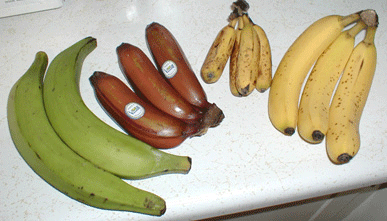
North American and European Consumers may have to adapt to a new banana if the Tropical Race 4 Panama Disease reaches Latin America. (Wikipedia Commons)
CURWOOD: It's Living on Earth, I'm Steve Curwood. Well, some pessimists have dubbed the potential cataclysm for the luscious yellow fruit "Bananageddon" - so to check on its status a decade on -- we turn back to Randy Ploetz who was featured in that 2004 story. Randy is a plant pathologist at the University of Florida. Welcome back to Living on Earth.
PLOETZ: Thank you.
CURWOOD: Professor Ploetz, did Bananageddon happen? Has the Tropical Race Four Panama disease made it out of Asia and into Latin America?
PLOETZ: In Latin America we don’t know yet. It certainly has made it to the Middle East. There are at least two locations in the Middle East, Jordan and Oman, also in Mozambique recently there was an export plantation of Cavendish there established by some Norwegian investors, but we don’t know whether it’s made its way into Latin America yet. Time will tell. But the way this thing has moved from Southeast Asia to the Middle East and Africa recently has us believing that it is possible, that it can make that next continental jump and can go from those areas to the Americas.
CURWOOD: Jordan, Mozambique...these aren’t exactly next door...how does a disease get there?
PLOETZ: Yeah, that’s one thing we’re concerned about. We’ve always known how this thing moves, and it’s traditionally in banana seed pieces is the easiest way for this thing to move great distances. We know from past work on this with Race One in the Americas a long time ago that movement in soil and on farm equipment in water - once this pathogen gets into a drainage basin and that water from a river or lake is used to irrigate the banana it’s a very effective way then to re-inoculate that crop every time you irrigate the crop. So that’s well understood. In this situation, from what we know, it’s possible that the pathogen has moved on workers’ clothing or shoes or by some other means to those areas, and if it’s that’s easy to move this thing great distances, it’s then possible to move it from Africa and the Middle East to the Americas. So that’s our big concern.
CURWOOD: How containable is this disease if it were to show up?
PLOETZ: It’s very difficult. Very, very difficult. There are no examples of anyone, knowing how bad this disease is, identifying an initial outbreak and being able to restrict that outbreak to a given area. It’s a really insidious kind of a cryptic hidden type of pathogen that really doesn’t rear its ugly head until it’s widespread and causing a lot of damage, so it’s very difficult to manage. And there are no fungicides that will manage it, there is no cultural practice that is known that can manage it, we’re kind of stuck between a rock and a hard place on that one.
CURWOOD: Back when Bob McCarty did this story for us in 2004, scientists were working on developing a genetically-engineered Cavendish banana that would resist this disease. So far, how much luck have they had?
PLOETZ: [LAUGHS] Not much. This is a really difficult disease to come to grips with. The banana is a very very difficult crop to improve, and unfortunately there aren’t a lot of scientists that are working on bananas. I mean, it’s very different than maize or soybeans or wheat where there are lots of scientists who are concerned about it. Banana, a very important crop, but very few scientists who are doing work to improve it.
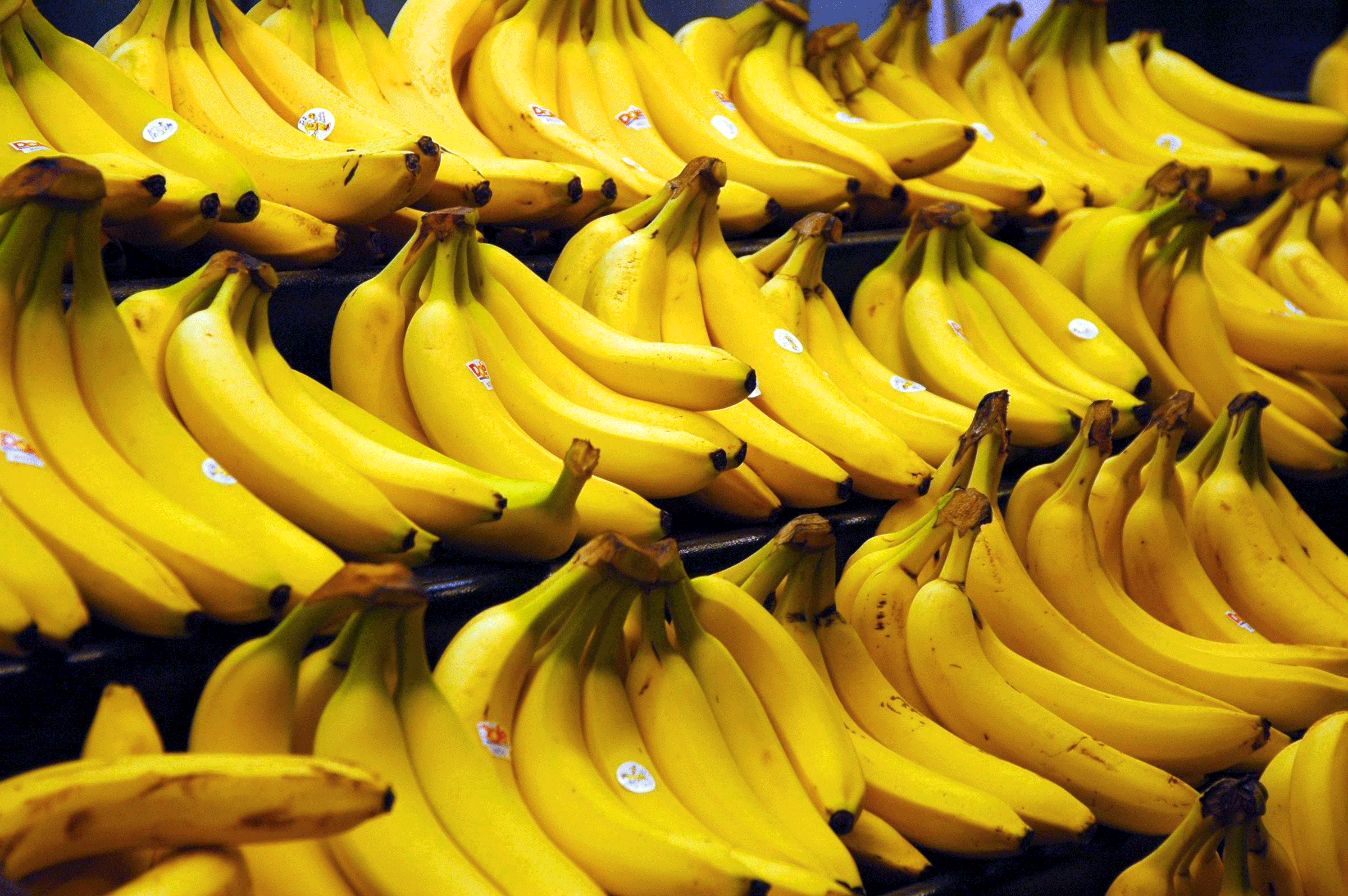
(Wikipedia Commons)
CURWOOD: What about introducing new species of bananas to market. You know those purple bananas or the little finger-sized ones we sometimes see in markets here? How might they do if the Cavendish needs to be replaced?
PLOETZ: Yeah, there are a lot of different types of bananas out there. Cavendish is just one of many different types that are available. The problem is the Cavendish is so so productive and consumers in the US and Europe expect Cavendish bananas. Between you and me, I mean, there are other better tasting bananas out there than Cavendish. The problem with those other bananas is to consumers like myself and others, they might taste better - the Cavendish consumer often doesn’t like those other tastes. And the problem with those other ones as well in addition to the non-Cavendish type taste, is that they don’t produce as well. So if you did plug those into a Cavendish-type production system, you just wouldn’t get the yields, and you’d have to charge quite a bit more to be able to sell those bananas to a consumer like you or myself in the developed world. If you go into Whole Foods and you look at Apple bananas for instance in the supermarket, they’re a dollar a pound, they’re a lot more expensive than Cavendish.
CURWOOD: Hmmm. Randy Ploetz is a plant pathologist at the University of Florida. Thanks so much for taking this time.
PLOETZ: It's my pleasure.
Related link:
Randy Ploetz
[MUSIC: Nicky Hopkins “ Banana Anna” from The Tin Man Was A Dreamer (Sony Music 1972)]
Beyond the Headlines

Clown fish in Papua New Guinea (photo: Nick Hobgood, Creative Commons 3.0)
CURWOOD: Time now to voyage beyond the headlines now with Peter Dykstra. He's the publisher of Environmental Health News, EHN.org, and DailyClimate.org and joins us as usual on the line from Conyers, Georgia. Hi there, Peter.
DYKSTRA: Well, hi there. Riddle me this, Steve: How do you get a fish not to smell?
CURWOOD: Let’s see. Uh, the refrigerator?
DYKSTRA: Well, if they’re still in the ocean, fish apparently can’t smell as well if they’re in acidified waters.
CURWOOD: OK. Tell me, Peter. How do you get ocean fish to do a sniff test?
DYKSTRA: Well, here’s something that was just published in the journal Nature Climate Change, our reporter Brian Bienkowski wrote up a summary of the research. Scientists from Australia and the U.S. studied reef fish near Papua New Guinea. And fish living in naturally acidic waters near volcanic seeps behaved differently in the study than fish in more chemically normal water.
CURWOOD: Well, if I were a fish near volcanic vent I think I might be a bit more careful.
DYKSTRA: Well, first of all, Steve, you’re not a fish, and actually the acidity makes them less careful, according to this research. They didn’t avoid their predators’ smell, the fish didn’t hide themselves for nearly as long. The scientists say there weren’t fewer fish in the more acidic water, just fish that behaved differently.
CURWOOD: But as more carbon goes into the atmosphere making ocean waters more acidic, this could be another huge impact then of global harming. What else do you have?
DYKSTRA: Well, you know, people concerned about climate change spend a lot of mental energy worrying about coal, and oil, and gas and other greenhouse gas producers, but nobody ever gets worked up over cows. Well, Steve, that’s why the Innovation Center for U.S. Dairy - and here I go in my best radio voice - is developing the Cow of the Future.
CURWOOD: Oh, get out.
DYKSTRA: No, it’s for real. The Innovation Center is funded by the dairy industry. It partners with groups like the World Wildlife Fund, and one of their biggest projects is to reduce methane emissions from cows. Of course, there are almost 90 million cows in the United States, and methane is a much more potent greenhouse gas than carbon dioxide.
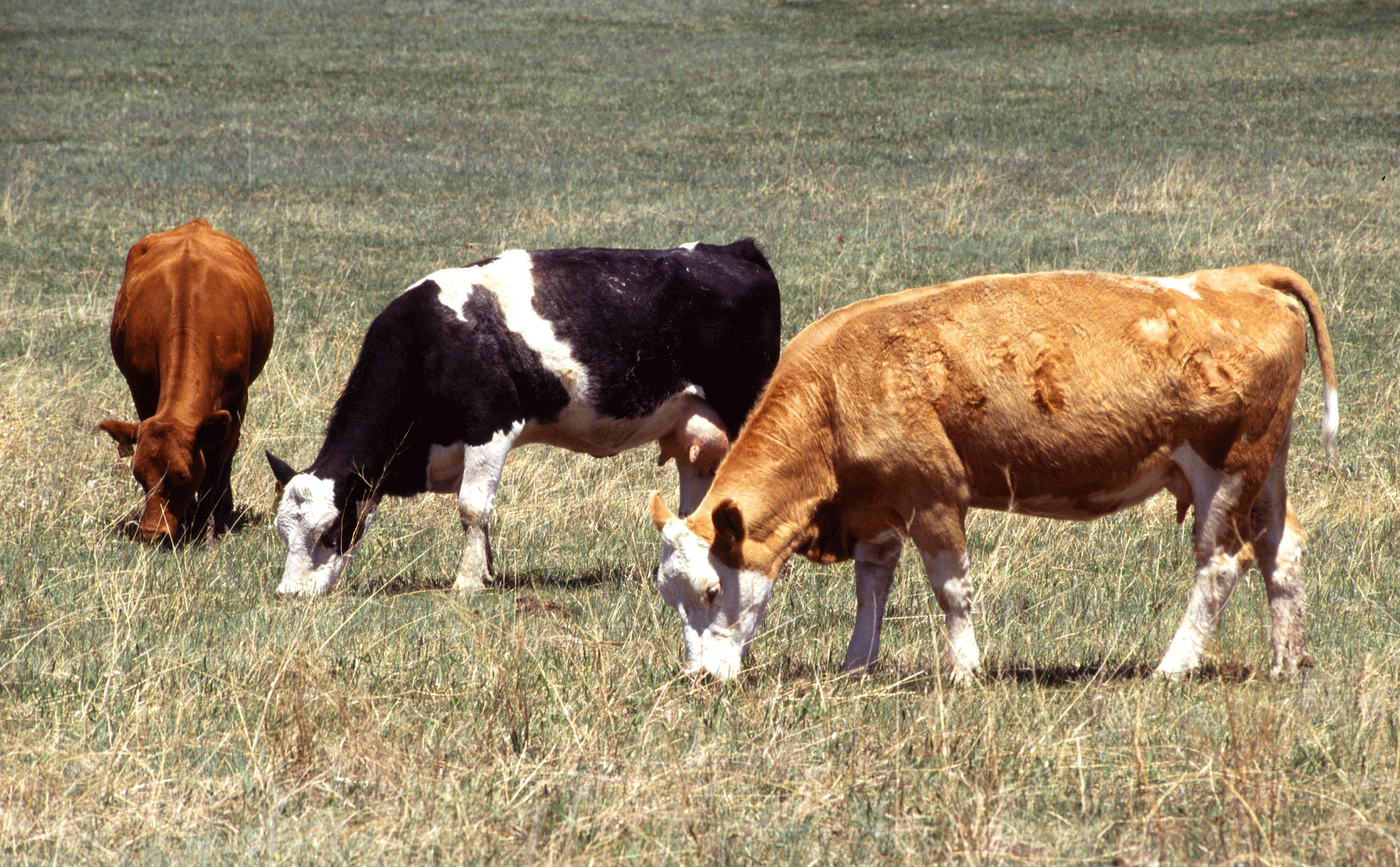
Dryland grazing on the Great Plains in Colorado. Each cow on a pasture can emit about 350 liters (230 grams) of methane per day. (photo: US Department of Agriculture)
CURWOOD: Peter, I think I know the answer to this, but why don’t you give us the poop on cows and methane?
DYKSTRA: Well, I don’t want to bring the FCC down on you for indelicate language, but let’s just say that cows have tailpipes, too. And they burp, and they poop, and they’re associated with farm equipment that contributes its own emissions. The Innovation Center has a goal of reducing cows’ carbon hoofprint by 25 percent in the next few years, partly by making dairy farming more efficient.
CURWOOD: But I see a little red flag here. When you hear “more efficient” farming, it often means more factory farms, which have their own environmental baggage and the cows don’t much like them either.
DYKSTRA: Yeah, you may be right that there’s a huge contradiction there, but the industry says they’re working on strategies to recover biogas from dairy farms, meaning from cows, instead of just releasing it. So we’ll see what happens.
CURWOOD: OK, Peter. What do you have on the calendar for us this week?
DYKSTRA: Well, I was thinking about one of the insults that’s often hurled at environmental advocates. They’re called “luddites.” The problem here is, I’m not sure that many of the people involved in this, including the accusers, have any idea what the name “luddite” means, or where it comes from.
CURWOOD: You have the floor...
DYKSTRA: Let’s journey back to about 1812. The Luddites were a group mostly of artisans and craftsmen. Their skills were less needed as the industrial revolution started up and mills began to take over their work. When the Luddites got mad, they attacked the mills. They burned and wrecked new machinery. But both the high and low point for the Luddite movement was 202 years ago this week, 1,000 of them got together they massed to destroy a mill, but they were driven back by an even bigger group gathered to protect the mill, and in the battle two Luddites died.
CURWOOD: And so where does the name come from?

“Leader of the Luddites” (photo: Published in May 1812 by Messrs. Walker and Knight, Sweetings Alley, Royal Exchange)
DYKSTRA: It comes from Ned Ludd. There’s a dispute whether or not Ned Ludd really existed, but he ended up having thousands of followers. He was said to be a teenager, sometimes described as a “dull-witted” teenager. He allegedly smashed a textile loom and started a movement. Dull-witted Ned became known eventually as “King Ludd” or “Captain Ludd” as the legend grew. Oh, and by the way, some of the stories say he lived in Sherwood Forest in Nottingham.
CURWOOD: So he shared mythological turf with Robin Hood, huh?
DYKSTRA: Yeah, and they both lived in a part of England that apparently had chronic law enforcement problems and lousy Sheriffs.
CURWOOD: Anything else before you go, Peter?
DYKSTRA: Just wanted to give a shout out to two environmental journalism colleagues, Dan Fagin wrote a tremendous book called “Tom’s River” that won the Pulitzer for nonfiction. Chris Hamby from the Center for Public Integrity did a great investigative series - it also won a Pulitzer. He reported on coal miners and black lung disease.
CURWOOD: And congratulations to them both. Peter Dykstra is publisher of Environmental Health News and the DailyClimate.org. Thanks so much for taking the time today, Pete.
DYKSTRA: Thanks a lot, Steve. We’ll talk to you soon.
Related links:
- Read more about Ocean Acidification and fish health
- Cow of the Future
- Read more on the history of the Luddites
CURWOOD: And there’s more of these stories at LOE.org.
[MUSIC: Haiku: Stephane Grapelli “Tournesol” from Stardust (1201 Music)]
Earthday Haikus

Matsuo Basho’s famous Haiku. (Photo: Jennifer Pack)
CURWOOD: After our interview with NOAA oceanographer Gregory Johnson who interpreted part of a dense UN report on climate change as haiku, we asked you to send us your own haiku to honor Earth Day, which also happens to fall during National Poetry month. Many listeners responded to our call, although not all of your poems celebrated our lovely world. For instance, James Gallagher from Pompton Plains, New Jersey, sent us a haiku he entitles "Blah New World".
Clean air, skies of blue,
Water to drink and swim in.
Ain't gonna happen!
CURWOOD: Most of our respondents were more upbeat though, or thoughtful…
BOISRAME: Hi, I'm Gabrielle Boisrame. I’m a graduate student at UC Berkeley in California, and I study environmental engineering, specifically eco-hydrology and water resources. So when I heard about this call for haikus about Earth Day, I thought about the way I think about Earth systems, a lot which is water. And lately in the news there’s been a lot of talk about water because of the drought, but a lot of the people that I work and go to school with they think that water systems are important all of the time, and people need to be talking about it, not just when there’s a crisis. And so that made me think of the following haiku:
A drought year is not
The only time scientists
Should be listened to
CURWOOD: And then there was this reply from a published poet, no less, paying homage to a 17th century master of the haiku form, Matsuo Basho.
SLIDER: This is Red Slider. I’m a poet, and I’m calling from Sacramento [California]. My earth haiku is one that was inspired by a very famous poem by Basho about frog splashes from which I was inspired to take my first line. And the poem itself reflects one of my convictions that our best and greatest hope for cleaning up the messes that we’ve gotten our planet into lies with the children who are going to have to deal with it. I do hope they survive us. Anyway, here’s my haiku.
Waiting for frog Splash!
tadpoles swim through the ripples
of children's voices.
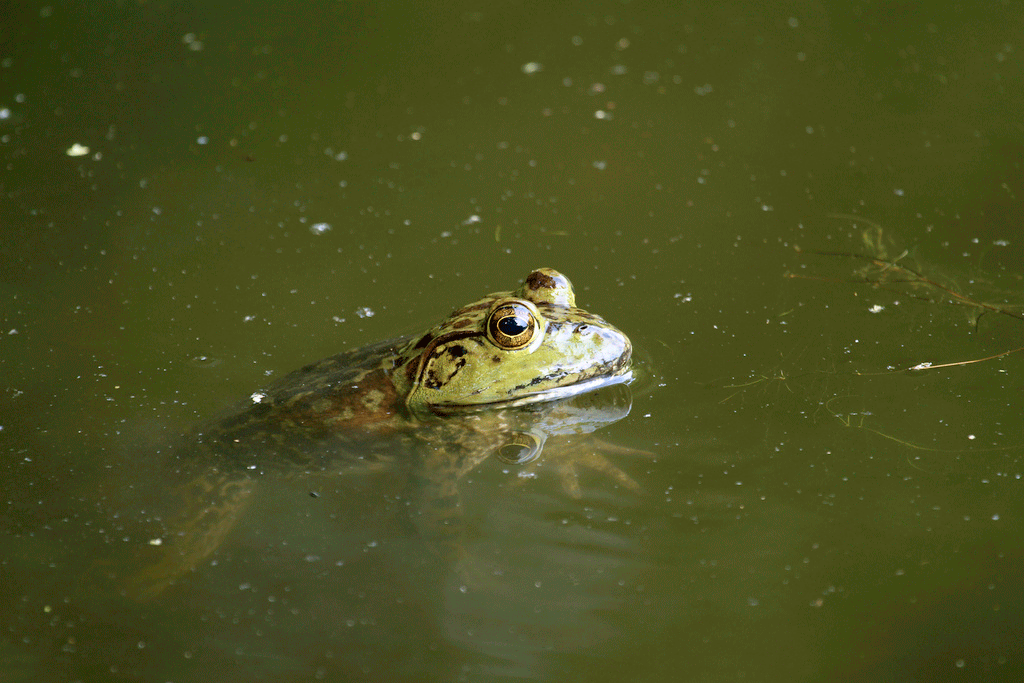
Frog in a pond (photo flickr user LPFearn, creative commons 2.0)
CURWOOD: We have more, and we'll play more next week, but not all of your poems obeyed the strict haiku form. Remember, it's three lines, the first line five syllables, the second line seven syllables, and the third line five again. Any Earth Day topic that inspires you, from spring flowers to climate worries to eco heroes, send your haiku on over.
The address is comments@loe.org. Once again, comments@LOE.org.
Or you can use our postal address it's PO Box 990007, Boston, Massachusetts, 02199. Or read your poem aloud on our listener line at 800-218-9988. That’s 800-218-9988. If you use the phone be sure to record your name and a number where we can call you back.
Related link:
Check out some more haikus at Times Haiku
[MUSIC: Stephane Grapelli “Tournesol” from Stardust (1201 Music)]
CURWOOD: Next time on Living on Earth, pet flea collars kill fleas and ticks, but can be dangerous for the household.
ROTKIN-ELLMAN: When kids come in contact with their pet, which they do on a daily basis, they come into contact with that very toxic pesticide.
CURWOOD: The EPA will ban some flea collars, but not all and not very soon. That's next time on Living on Earth.
We leave you this week with what's been called "the most beautiful sound in the world”, but you can make up your own mind.
[SOUNDTRACK: Earth Ear: “Borneo Frogs” from UK Soundcloud: http://grist.org/list/singing-frogs-officially-the-most-beautiful-sound-in-the-world/]
[FROG SOUNDS]
"Dusk by the Frog Pond" captures the chorus in a swamp on the island of Borneo, recorded by Australian photographer and sound recordist Marc Anderson.
[FROG SOUNDS]
The recording won a competition run by the UK Sound Cloud company. So, the most beautiful sound in the world? You be the judge.
[FROG SOUNDS]
CURWOOD: Living on Earth is produced by the World Media Foundation. Naomi Arenberg, Clairissa Baker, Bobby Bascomb, Emmett FitzGerald, Helen Palmer, Catalina Pire-Schmidt, Adelaide Chen, James Curwood and Jennifer Marquis all help to make our show. Jeff Turton is our technical director; we had engineering help this week from Jacob Rego. Alison Lirish Dean composed our themes. You can find us anytime at LOE.org, and like us on our Facebook page - it’s PRI’s Living on Earth. And we tweet from @LivingOnEarth. I'm Steve Curwood. Thanks for listening.
ANNOUNCER 1: Funding for Living on Earth comes from the Grantham Foundation for the protection of the environment. Supporting strategic communications and collaboration in solving the world’s most pressing environmental problems. The Kendeda Fund, furthering the values that contribute to a healthy planet, and Gilman Ordway for coverage of conservation and environmental change. Living on Earth is also supported by a friend of The Nation, where you can read such environmental writers as Wen Stephenson, Bill McKibben, Mark Hertsgaard, and others at TheNation.com. This is PRI, Public Radio International.
ANNOUNCER 2: PRI, Public Radio International
Living on Earth wants to hear from you!
Living on Earth
62 Calef Highway, Suite 212
Lee, NH 03861
Telephone: 617-287-4121
E-mail: comments@loe.org
Newsletter [Click here]
Donate to Living on Earth!
Living on Earth is an independent media program and relies entirely on contributions from listeners and institutions supporting public service. Please donate now to preserve an independent environmental voice.
NewsletterLiving on Earth offers a weekly delivery of the show's rundown to your mailbox. Sign up for our newsletter today!
 Sailors For The Sea: Be the change you want to sea.
Sailors For The Sea: Be the change you want to sea.
 The Grantham Foundation for the Protection of the Environment: Committed to protecting and improving the health of the global environment.
The Grantham Foundation for the Protection of the Environment: Committed to protecting and improving the health of the global environment.
 Contribute to Living on Earth and receive, as our gift to you, an archival print of one of Mark Seth Lender's extraordinary wildlife photographs. Follow the link to see Mark's current collection of photographs.
Contribute to Living on Earth and receive, as our gift to you, an archival print of one of Mark Seth Lender's extraordinary wildlife photographs. Follow the link to see Mark's current collection of photographs.
 Buy a signed copy of Mark Seth Lender's book Smeagull the Seagull & support Living on Earth
Buy a signed copy of Mark Seth Lender's book Smeagull the Seagull & support Living on Earth

